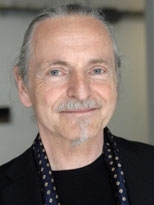MIT Visual Arts Professor Krzysztof Wodiczko has long pioneered the use of communication technology to allow the alienated, isolated or outcasts of society tell their stories to the world.
Using large-scale projections on public buildings, he has made it possible for grieving mothers to speak of murdered children from the surface of Boston's Bunker Hill Monument, Mexican factory girls to tell their stories from a Tijuana building, and atomic bomb survivors to talk from the A-Bomb Dome in Hiroshima.
Now as part of a major new piece at the 53rd Venice Biennale -- considered by many the world's most important venue for contemporary art -- Wodiczko is using high-definition, large-scale images to give a voice to immigrants from Chechnya, Ukraine, Libya, Vietnam, Sri Lanka and Morocco who seek work in Europe.
This week, Wodiczko opened a solo video installation inside the Polish pavilion at the Venice exhibition about the plight of immigrants in Europe. Created at the request of the Polish government, the installation will run through November.
"I've done a lot of projects focusing on immigrants all over the world," Wodiczko says. "My hope was that there would be no need to return to this topic. Unfortunately, we are facing new waves of xenophobia in Europe."
Wodiczko, an internationally known multimedia artist who has twice served as director of MIT's Center for Advanced Visual Studies, has been creating politically charged slide and video projections for galleries and on buildings and monuments for nearly 30 years. He has produced evocative artifacts such as his provocative 1983 "Homeless Vehicle Project," a cart and sleeping compartment for street people. His work has been featured at the Venice Biennale before, in 1986 and 2000.
Wodiczko says his work has been shaped by the 18 years he has spent at MIT, and especially by fruitful collaborations with students and colleagues. For example, his 2001 project with Mexican factory workers in Tijuana utilized MIT-developed wearable projection equipment that allowed a public facade to be animated by the projected faces of young women. Another project, which incorporated a video screen into a walking stick, used movement-sensing technology designed by members of the Media Lab's Physics and Media Group to let the holder manipulate sound and images on the staff with a gesture.
Wodiczko hopes that his solo work for the Polish pavilion will force people to think about what it means to be European as more non-white immigrants move to the continent. Moving images will be projected into what appear to be windows showing immigrants working at jobs, such as painting houses, or talking about their lives. Wodiczko has made the images slightly blurry, as if glimpsed through thick glass to create the impression of people who are among us and yet far away.
Working through social agencies that aid legal and illegal immigrants, Wodiczko arranged for immigrants in Poland and Italy to be videoed by a professional film company; he then worked with another company to turn that video into high-quality projections. A soundtrack, based on the immigrants' stories, was recorded by actors in an Italian studio, as many feared that their voices would be recognized.
Wodiczko is now working on a project to highlight war veteran issues at Governors Island in New York Harbor; he will have a show on a similar topic at Boston's Institute of Contemporary Art in the fall.
A native of Poland who emigrated to Canada and then to the United States, Wodiczko says new communication technology, such as wearable cameras, holds great potential for people to "transmit some truth of their life and their experience" for others to hear and see.
"It is impossible to make any change in the world if one doesn't feel a stranger, if one doesn't see the world from the point of view of strangers," he says.






